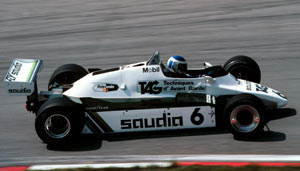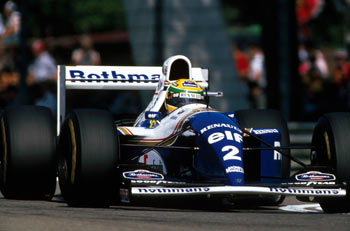Williams F1
Founded: 1968 (active since 1973) Website: http://www.williamsf1.com/ Managing director & Team principal: Frank Williams Deputy team principal: Claire Williams (since Jan 2013) Technical director: Patrick Head (1977-2004), Sam Michael (2004-2011), Mike Coughlan (2012-Aug 2013), Pay Symonds (since Aug 2013) Chief designer: Gavin Fisher (1997-2005), Ed Wood (since 2006) Chief aerodynamicist: Adrian Newey (1991-1997), Geoff Willis (1998-2002), Antonia Terzi (2002-Nov 2004), Loic Bigois (Dec 2004-2010), Jason Somerfield (since 2011) Team manager: Dickie Stanford Director of engineering: Patrick Head (2004-2011) Chief race engineer: Xevi Pujolar (since 2013) |
Williams is a well respected name in Formula One as they impressed many with their impressively efficient racing cars. The team quickly rose to the top after its debut and simply dominated the sport through the 1990. Fortunes though were not always so good.
 Frank Williams entered Formula 1 as a private entrant in 1969 but it was not until 1977 that the current team began to take shape. Things really got moving when Frank joined forces with talented designer Patrick Head and managed to secure major backing from Saudia airlines. The duo set up a factory in Didcot where Head penned the stunning Williams FW07. Clay Regazzoni scored the teams first win, fittingly on home soil. Four further wins from Australian Alan Jones completed a successful year that left the team second in the constructors' championship.
Frank Williams entered Formula 1 as a private entrant in 1969 but it was not until 1977 that the current team began to take shape. Things really got moving when Frank joined forces with talented designer Patrick Head and managed to secure major backing from Saudia airlines. The duo set up a factory in Didcot where Head penned the stunning Williams FW07. Clay Regazzoni scored the teams first win, fittingly on home soil. Four further wins from Australian Alan Jones completed a successful year that left the team second in the constructors' championship.
Jones clinched the top spot in 1980 and then in 1982 Keke Rosberg gave the team a second driver's title. This was the dying days of the kit car operation where most teams simply bought a Ford Cosworth and plugged it into the back of a car. Stakes were being raised and to give his team the best chance in the forthcoming turbo age Frank opted for Honda power. The relationship took some time to gel, but in 1986 Nigel Mansell and Nelson Piquet dominated until tyre problems allowed McLaren's Alain Prost to slip through at the final round. The team's supremacy was doubly surprising after Frank was paralysed in a road accident while at a test session at the Paul Ricard circuit in March 1986.
The Honda partnership ended in 1987, but in their final year together, Nelson Piquet clinched the drivers' championship and the team took their fourth constructors' cup. 1988 was a difficult year, the team failing to win a race with their normally-aspirated Judds in a final year of turbo domination.
Renault re-entered Formula One in 1989, and opted for Williams. Theirs was to be a partnership made in heaven as Williams began a period of total domination of the racing scene. Williams challenged strongly for the championship in 1991, but had to wait for 1992 for a dominant double. Three-times world champion Alain Prost took Mansell's seat for 1993, and added a fourth title to his tally. With the assistance of test-graduate Damon Hill, the team took their sixth constructors' title.
 When Prost retired at the end of the season, Ayrton Senna took the lead seat and was expected to dominate. After a troubled start of the season, the great Brazilian fell victim of a tragic accident at Imola, leaving Hill in charge of the team. Together with rookie David Coulthard, the team managed to secure its seventh constructors' championship.
When Prost retired at the end of the season, Ayrton Senna took the lead seat and was expected to dominate. After a troubled start of the season, the great Brazilian fell victim of a tragic accident at Imola, leaving Hill in charge of the team. Together with rookie David Coulthard, the team managed to secure its seventh constructors' championship.
Despite a superb handling car for 1995 the team failed to clinch either championship, but 1996 and 1997 saw them back at the top with another pair of titles for Damon Hill and Jacques Villeneuve. Despite the twin victories many observers began to see cracks in the teams ability to contain the rapidly improving opposition.
When Renault left Formula 1 at the end of the '97 season, the team's dominance was left seriously in doubt. Despite setting some impressive times in testing, both Villeneuve and Frentzen struggled to match the pace of the McLarens and as a result they spent 1998 battling to get into the points. As a result the team suffered from their most uncompetitive season for a decade and failed to win a single race. For champion Villeneuve, this was a very bitter pill to swallow - scoring just 20 championship points and two podium placings. By the end of the season, both drivers had had enough and announced their departure from the team.
The next year wasn't much of an improvement to 1998. The dominant red on the car and a woodpecker on the nose did not help the team much further. Ralf Schumacher who came over from Jordan practically saved the season for Williams as CART champion Alessandro Zanardi had a hard time adopting to F1.
 In year 2000 the Williams Team changed to the blue and white colours of BMW and used the new BMW engine. While the first year was a little bit too early to shine for Ralf Schmacher and younster Jenson Button, it only went better and better with extremely powerful BMW engines. The team hired Juan Pablo Montoya as a replacement for Jenson Button and saw the Columbian CART champion do by far much better than Zanardi in 1999. 2003 was the highpoint of the BMW alliance. Montoya had the upper hand in the team and drove from one pole position to another while proving the BMW engine's strenght by driving the (at that time) fastest lap ever in F1 during Monza qualifying.
In year 2000 the Williams Team changed to the blue and white colours of BMW and used the new BMW engine. While the first year was a little bit too early to shine for Ralf Schmacher and younster Jenson Button, it only went better and better with extremely powerful BMW engines. The team hired Juan Pablo Montoya as a replacement for Jenson Button and saw the Columbian CART champion do by far much better than Zanardi in 1999. 2003 was the highpoint of the BMW alliance. Montoya had the upper hand in the team and drove from one pole position to another while proving the BMW engine's strenght by driving the (at that time) fastest lap ever in F1 during Monza qualifying.
One year after the successes, the Williams team hired Antonia Terzi from Ferrari as head of aerodynamics and came up with the tusk nosed Williams FW26. The car proved to be a trouble child and the team fired Terzi and reverted to a conventional nose. More and more problems arose between the management and BMW for not allowing BMW to buy a majority stake in the team. Montoya on the other hand was unsatisfied by the treatment he got at the team and decided to leave for McLaren in 2005. Although he managed to win the last race of 2004, the next season, McLaren proved to be the right choice for Juan Pablo.
As also Ralf Schumacher left to Toyota, Frank Williams hired the services of Mark Webber and Nick Heidfeld, only to drive halfway the pack during 2005. The only really good result came in Monaco where the two Williams F1 cars finished on the podium behind winner Kimi Raikkonen in a McLaren MP4-20.
2006 introduces a new era for Williams as BMW decided to start their own team by buying the Swiss Sauber team. Williams runs 2006 with a V8 Cosworth engine driven by Webber and GP2 winner Nico Rosberg, son of Keke Rosberg who won the championship with Williams in 1982. The team had a hard time during the season and eventually ended up 8th in the constructor's title, the worst result since their debut. For 2007, AT&T was signed as a sponsor while the cars will be driven by Wurz and Rosberg. Mark Webber left the team for Red Bull Racing after two dissappointing years.
Both drivers had a better Williams FW29 at their possession, powered by a Toyota RVX-07 engine. The team decided to buy a manufacturer's engine as Cosworth, as a private company was having trouble keeping up with the development at the price Williams was willing to pay. Eventually Cosworth left Formula One as no other team was interested in its engines. The combination proved to be better than 2006, putting the team in 5th in the constructor's standings of 2007.
A year later, Wurz decided to quit racing and joined Honda as a test driver. Nico Rosberg was then joined by Kazuki Nakajima, a promising Japanese youngster. In the course of the year, Williams also bought AHP to form Williams Hybrid Power, aiming to prepare an optimum KERS system for 2009.
All in all, it proved to be a slightly disappointing season, although Rosberg's second place finish at the Singapore night race was the best result for the team since Juan Pablo Montoya's win at the Brazilian GP of 2004.
It turned out however that the flybrid system of AHP was not well suited for the challenge of F1, hence the team opted for a battery storage KERS like the rest of the field, in cooperation with Magnetti Marelli. At the end of a troubled 2009, the team also announced to drop Toyota engines and go for 'a long term contract' with Cosworth. Two further disappointing seasons for the team led to Cosworth being dropped as well, as the British engines clearly lacked top end power and reliability compared to all other competitors.
So, for 2012, Williams reunited with Renault, while Rubens Barrichello's career ended as the team opted to retain Pastor Maldonado for a second year and sign on Bruno Williams. The British had also taken on Mike Coughlan as their technical director, after the latter was ousted from McLaren in an infamous spy scandal. He was set to replace Sam Michael who left to join McLaren, taking part of the blame for the disappointing seasons Williams struggled through. Following a string of dismal years, Williams was on the pace, especially in the first 6 races of the season, including a win for Maldonado at the Spanish Grand Prix. The team however struggled with front end development of its Williams FW34, but returned to the front of the field at the Singapore Grand Prix.
At the beginning of 2013, Director and shareholder Toto Wolff announced he would join Mercedes AMG, a few month later followed by Williams appointing Claire Williams as its deputy team principal while also replacing its group CEO. Performance wise, the new Williams FW35 proved to be disastrous with the team scoring its first point only at the Hungarian GP, round 10 of the championship. Even though the car was only a development of the successful FW34, it proved to be difficult to drive and usually qualified between 16th and 20th positions. Mike Coughlan took the blame, and the team opted to hire Pat Symonds in an attempt to reverse its fortunes. By then, it also announced that it would use Mercedes engines in 2014, terminating its partnership with Renault after just 2 years.
